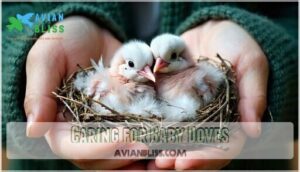This site is supported by our readers. We may earn a commission, at no cost to you, if you purchase through links.

Baby Dove skincare products offer gentle, hypoallergenic formulas that protect your little one’s delicate skin with moisture-rich ingredients.
These products work like a protective shield for sensitive baby skin.
On the flip side, if you’ve spotted a baby dove bird, you’re seeing nature’s most vulnerable creatures.
These tiny nestlings depend completely on their parents for warmth and nutrition.
They can’t survive on their own yet.
Whether you’re shopping for skincare or caring for wildlife, understanding the specific needs makes all the difference in providing proper care, and it’s about giving them a protective environment.
Table Of Contents
- Key Takeaways
- Baby Dove Overview
- Top 8 Baby Dove Products
- Baby Dove Skin Care
- Baby Dove Bird Characteristics
- Caring for Baby Doves
- Frequently Asked Questions (FAQs)
- What is called a dove baby?
- What does a dove look like as a baby?
- What to do with a baby dove that fell out of nest?
- Why are baby doves on the ground?
- Is baby Dove a good baby wash?
- Is baby Dove a hypoallergenic wash?
- Is baby Dove safe for babies?
- What products does baby Dove offer?
- What is baby Dove?
- Is baby Dove fragrance free?
- Conclusion
Key Takeaways
- You’ll find Baby Dove skincare products offer hypoallergenic, dermatologist-tested formulas that protect your baby’s delicate skin, which is 30% thinner than adult skin and loses moisture five times faster.
- You should choose from specialized Baby Dove lines like Sensitive, Fragrance Free, or Eczema Care depending on your baby’s specific skin needs, with products containing 100% skin-natural nutrients and prebiotic moisture.
- You don’t need to rescue every baby dove you see on the ground – fledglings learning to fly are normal, and you should only intervene if the bird shows visible injuries, has no parental care for over 3 hours, or displays obvious distress.
- You can identify baby doves by their developmental stages: nestlings (0-14 days) have sparse down feathers and closed eyes, while fledglings (15-25 days) have most feathers and can flutter around as they learn independence.
Baby Dove Overview
You’ll discover Baby Dove as a trusted skincare brand that creates gentle, hypoallergenic products specifically designed for your newborn’s delicate skin.
This thorough guide covers everything you need to know about Baby Dove’s top-rated products and essential care tips to keep your little one’s skin healthy and protected.
Baby Dove Definition
When you hear "Baby Dove," you’re likely thinking of gentle skincare products designed for your little one’s delicate skin.
Baby Dove represents a trusted brand philosophy centered on hypoallergenic formulas that respect skin sensitivity.
These baby dove products contain gentle ingredients that build parent trust through proven safety.
Baby dove sensitive and baby dove newborn lines offer specialized care your baby deserves.
Baby Dove History
Baby Dove’s journey began when Dove recognized parents needed specialized care for delicate newborn skin.
The brand’s evolution reflects deep understanding of baby skincare needs, developing from simple cleansers to extensive product lines.
Here are three key milestones in Baby Dove’s development:
- Brand Origins – Launched as Dove’s dedicated baby division, focusing on gentle formulations
- Product Evolution – Expanded from basic baby dove wash to include baby dove lotion and baby dove shampoo
- Marketing Timeline – Built trust through dermatologist-tested promises and parent-focused campaigns
Baby Dove Benefits
With Baby Dove, you get products designed for gentle cleansing and moisture retention, perfect for sensitive skin.
Baby Dove delivers the gentle care your little one’s delicate skin deserves every day.
Their hypoallergenic formula guarantees safe, tear-free baths, giving you peace of mind.
Whether it’s Baby Dove Sensitive or Baby Dove Fragrance Free, each product supports delicate skin with nourishing care.
Baby Dove Moisturizing solutions are as gentle as your love, making parenting easier with hypoallergenic formula and gentle cleansing.
Top 8 Baby Dove Products
You’ll find the perfect Baby Dove products to care for your little one’s delicate skin in our carefully selected top eight recommendations.
These gentle, dermatologist-tested formulas work beautifully for sensitive newborn skin and give you confidence in your daily care routine, with delicate skin being a key consideration.
1. Gentle Baby Skin Care Wash
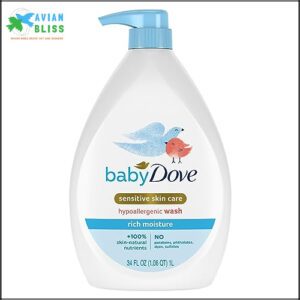
From the moment you hold your little one, their delicate skin deserves nothing but the gentlest care.
Baby Dove’s Gentle Baby Skin Care Wash creates a rich, luxurious lather that contains 1/3 baby lotion to keep skin incredibly soft and smooth.
You’ll love how this dermatologist-tested formula cleanses without stripping away natural moisture.
It’s hypoallergenic and tear-free, making bath time peaceful for both of you.
This trusted wash nourishes while it cleanses, leaving your baby’s skin feeling pampered and protected.
Best For: Parents seeking a gentle, tear-free baby wash that moisturizes and protects their baby’s delicate skin.
- Hypoallergenic and tear-free, ensuring a stress-free bath time.
- Contains 1/3 baby lotion for extra hydration and softness.
- Dermatologist-tested for safe, gentle cleansing.
- May not include fragrance-free options in this specific product.
- Designed for general use, not for specific skin conditions like eczema.
- Slightly higher price point compared to basic baby washes.
2. Fragrance free baby skin wash

When your little one has sensitive skin, choosing the right wash becomes essential for their comfort.
Baby Dove’s Fragrance Free Moisture Hypoallergenic Baby Wash delivers gentle cleansing without irritating delicate skin.
This 20-ounce bottle contains 100% skin-natural nutrients and prebiotic moisture that support your baby’s natural skin health.
It’s completely free from dyes, parabens, sulfates, and phthalates.
The tear-free formula works perfectly for newborns and creates a rich, creamy lather that leaves skin clean, soft, and properly hydrated after every bath, providing proper hydration.
Best For: Babies with sensitive, eczema-prone skin, including newborns, needing a gentle, fragrance-free wash.
- Fragrance-free and hypoallergenic, ideal for delicate skin.
- Formulated with 100% skin-natural nutrients and prebiotic moisture.
- Tear-free, safe, and dermatologist-tested for newborn care.
- Not suitable for those looking for scented options.
- Requires careful rinsing to avoid residue.
- May not address severe skin conditions beyond mild eczema.
3. Baby Dove Sensitive Skin Wash
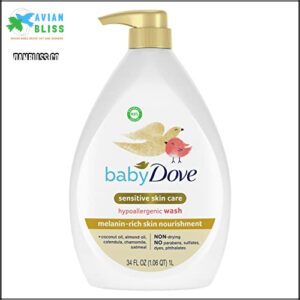
When your precious one has delicate skin that needs extra gentle care, this wash becomes your trusted ally.
Baby Dove Sensitive Skin Wash contains 95% naturally derived ingredients like coconut oil, almond oil, and soothing chamomile.
It’s completely free from harsh chemicals, parabens, and sulfates that can irritate sensitive skin.
The hypoallergenic formula prevents dryness while maintaining your baby’s natural moisture barrier.
Perfect for melanin-rich skin, it cleanses gently without causing flaking or irritation during daily bath time routines, making it a great choice for sensitive skin care with naturally derived ingredients.
Best For: Babies with sensitive, melanin-rich, or eczema-prone skin needing gentle, nourishing care.
- Hypoallergenic and free from harsh chemicals like parabens and sulfates.
- Enriched with natural ingredients like coconut oil, almond oil, and chamomile.
- Helps maintain skin’s natural moisture barrier and prevents dryness.
- Delicate scent may not be preferred by those seeking fragrance-free options.
- May not lather as much due to the absence of sulfates.
- Requires consistent use to see long-term benefits for sensitive skin.
4. Baby Sensitive Skin Moisturizing Lotion
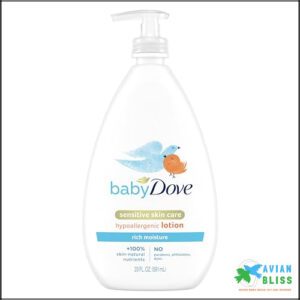
Gentle hydration becomes your daily superhero when you choose Baby Dove Sensitive Skin Moisturizing Lotion.
This 20-ounce bottle delivers 24-hour moisture that won’t quit on your little one’s delicate skin.
You’ll love how it’s packed with 100% skin-natural nutrients and prebiotic moisture that actually supports your baby’s natural skin health.
It’s hypoallergenic, pH-neutral, and completely free from dyes, parabens, and phthalates.
Dermatologists, pediatricians, and ophthalmologists have all given it their stamp of approval for newborn use.
Best For: Newborns and babies with sensitive, delicate skin.
- Provides 24-hour hydration with 100% skin-natural nutrients.
- Hypoallergenic and free from dyes, parabens, and phthalates.
- Approved by dermatologists, pediatricians, and ophthalmologists.
- Limited to post-bath use for hydration.
- Larger 20 oz. size may not be travel-friendly.
- May not address severe skin conditions.
5. Fragrance Free Baby Body Lotion
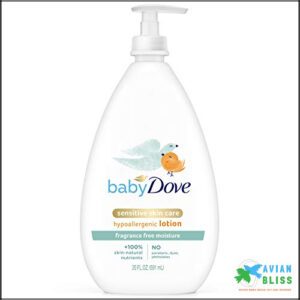
When your baby’s skin needs moisture without any added scents, this fragrance-free formula delivers exactly what you’re looking for.
You’ll get 24-hour hydration that soothes dry skin from the very first use.
Made with 100% skin-natural nutrients, it helps your little one’s delicate skin retain its natural moisture all day long.
It’s perfect for newborns and babies with sensitive or eczema-prone skin. Plus, you won’t find any dyes, parabens, or phthalates in this dermatologist-tested formula.
Best For: Parents seeking a gentle, fragrance-free lotion for sensitive or eczema-prone baby skin.
- Provides 24-hour hydration and soothes dry skin from the first use.
- Made with 100% skin-natural nutrients and free from dyes, parabens, and phthalates.
- Hypoallergenic, dermatologist-tested, and safe for newborns.
- May not appeal to those who prefer scented baby products.
- The 5.7 FL OZ size might not last long with frequent use.
- Requires careful application to avoid eye contact.
6. Baby Dove Sensitive Skin Lotion
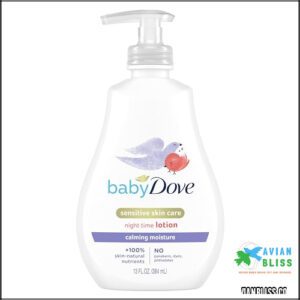
When bedtime battles leave your little one’s skin feeling dry and irritated, this chamomile-scented lotion becomes your nightly hero.
Made with 100% skin-natural nutrients and prebiotic moisture, it gently hydrates sensitive skin for up to 24 hours.
You’ll love how it supports your baby’s natural skin barrier while creating the perfect calming atmosphere for sleep.
Hypoallergenic and free from harsh chemicals, it’s pediatrician-tested for daily use. Four out of five parents swear by its effectiveness in their bedtime routine.
Best For: Parents seeking a hypoallergenic, chamomile-scented lotion to hydrate and soothe their baby’s sensitive skin during bedtime.
- Made with 100% skin-natural nutrients and prebiotic moisture.
- Hypoallergenic and safety-tested by pediatricians.
- Provides 24-hour hydration and supports the skin’s natural barrier.
- May not suit babies sensitive to fragrances despite being gentle overall.
- Effectiveness for calming sleep may vary by child.
- Chamomile scent might not appeal to all parents.
7. Baby Dove Soothing Eczema Wash

Managing eczema feels like walking on eggshells, but you don’t have to face it alone.
Baby Dove Soothing Eczema Wash transforms bath time into healing time with colloidal oatmeal that calms irritated skin.
This National Eczema Association-certified formula contains 100% skin-natural nutrients while staying free from fragrances, parabens, and sulfates.
You’ll love how it gently cleanses without stripping moisture, helping prevent those heartbreaking flare-ups.
Pediatric dermatologists developed this tear-free wash specifically for your little one’s sensitive, eczema-prone skin.
Best For: Parents of newborns and babies with sensitive, eczema-prone skin seeking gentle, tear-free cleansing.
- Free from fragrances, parabens, and sulfates.
- Contains colloidal oatmeal to soothe irritated skin.
- Pediatrician and dermatologist recommended for eczema care.
- May not be as effective for severe eczema without additional treatments.
- Slightly pricier than generic baby washes.
- Limited to a 2-count pack size, which may not suit all needs.
8. Baby Dove Moisture Care Set

For complete skincare coverage, you’ll love this thoughtfully curated bundle.
The Baby Dove Moisture Care Set includes Rich Moisture Tip to Toe Wash (6.5oz), Rich Moisture Baby Lotion (6.5oz), and Sensitive Moisture Baby Wipes.
Each product contains 100% skin-natural nutrients and prebiotic moisturizers that care for your baby’s microbiome.
This hypoallergenic, dermatologist-tested trio works together to maintain your little one’s natural moisture balance.
It’s perfect for gift-giving or stocking up on essentials that’ll keep delicate skin soft and protected.
Best For: Parents looking for gentle, hypoallergenic skincare for their baby’s sensitive skin.
- Includes 100% skin-natural nutrients and prebiotic moisturizers.
- Hypoallergenic and dermatologist-tested for safety.
- Great for maintaining skin’s natural moisture balance.
- Only available in specific bundle sizes.
- Some products contain fragrance, which may not suit every baby.
- Packaging options may vary depending on retailer.
Baby Dove Skin Care
Your baby’s skin is 30% thinner than yours and loses moisture five times faster, making gentle care absolutely essential for healthy development.
Baby Dove’s hypoallergenic products give you the confidence to protect that delicate skin barrier while supporting your little one’s unique needs every single day.
Baby Skin Types
Your little one’s skin type determines everything from moisture levels to product selection.
Some babies have naturally sensitive skin that reacts quickly, while others handle most products well.
Genetic factors and environmental impact shape these differences.
Baby dove sensitive and baby dove hypoallergenic products work best for delicate baby skin types, offering gentle care that adapts to your child’s unique needs.
Baby Skin Conditions
Spotting baby skin conditions early helps you choose the right care approach.
Eczema triggers like harsh soaps can worsen sensitive skin, while diaper rash develops from prolonged wetness.
Cradle cap appears as yellow scales on the scalp.
Heat rash shows up as tiny red bumps.
Dryness causes flaky patches.
Baby Dove hypoallergenic products address these concerns gently, providing a solution for sensitive skin.
Baby Skin Care Routine
A simple baby skin care routine works wonders for your little one’s delicate skin.
Start with gentle bathing frequency – two to three times weekly prevents dryness.
Follow each bath with moisturizing importance through Baby Dove products.
Consider using gentle cleansers during bath time.
Change diapers promptly to avoid irritation.
Include sun protection when outdoors.
Add massage benefits during lotion application for bonding and circulation.
Baby Skin Care Tips
Your baby’s skin deserves the gentlest touch possible.
Here are proven baby skin care tips that make all the difference:
- Gentle Cleansing – Use lukewarm water and fragrance-free baby dove products to protect delicate skin
- Moisturizing Methods – Apply lotion while skin’s still damp to lock in hydration
- Diaper Rash Prevention – Change diapers frequently and let skin air-dry
- Sun Protection – Keep babies under six months in shade; use protective clothing
Baby Dove Bird Characteristics
When you’re learning to identify baby doves, you’ll notice they look quite different from their adult parents with their fluffy down feathers and smaller size.
Understanding these key physical traits and developmental stages will help you recognize whether you’ve found a nestling that needs immediate care or a fledgling that’s simply learning to fly.
Physical Characteristics of Baby Doves
Newborn doves look nothing like their parents.
You’ll notice their tiny pink bodies covered in sparse, fuzzy down instead of sleek feathers.
Their oversized beaks seem disproportionate to their marble-sized heads.
Stubby legs can barely support their weight.
Plumage development happens gradually – those signature gray-brown feather patterns won’t appear for weeks.
Size variations depend on species and nutrition.
Age-Based Developmental Stages
Understanding your baby dove’s development helps you provide proper care at each stage.
From hatching through 30 days, these birds experience rapid Childhood Growth. During their first 12 days as nestlings, both parents feed them consistently.
Around day 15, they’ll fledge and explore outside the nest. By 30 days, most achieve independence—marking complete Adolescent Changes in their brief but remarkable journey to gain independence.
Differences Between Nestlings and Fledglings
Recognizing nestling characteristics versus fledgling behavior helps you respond appropriately when finding baby doves.
Nestlings appear nearly naked with few feathers and can’t hop or grip properly – they need immediate help if found outside their nest.
Fledglings look awkward but have most feathers and can flutter around.
This development stages knowledge determines whether parental care intervention is necessary for survival rates.
Juvenile Vs. Adult Mourning Doves
As your baby dove matures, you’ll notice striking changes that signal its journey to adulthood.
Juvenile mourning doves display distinct characteristics that set them apart from their parents.
Here are three key differences you’ll observe:
- Plumage Differences: Juveniles have duller, brownish feathers with white-tipped wing coverts, while adults sport iridescent neck patches and cleaner gray-brown coloring.
- Vocalizations: Young doves produce softer peeping sounds compared to adults’ distinctive cooing calls.
- Behavior Patterns: Juveniles remain ground-bound longer, showing less coordinated flight skills than experienced adults.
Caring for Baby Doves
When you find a baby dove that needs help, you’re taking on a rewarding but challenging responsibility that requires knowledge and patience.
You’ll need to understand their specific dietary needs, feeding schedules, and development stages to give these delicate birds the best chance at survival and eventual release back to the wild.
Baby Dove Diet and Nutrition
Your feathered friend’s nutritional journey starts with crop milk – nature’s perfect formula packed with 50-60% protein for rapid growth.
As they mature, you’ll introduce finely chopped vegetables and fruits. Consider baby dove hypoallergenic formula options if needed, ensuring proper nutrient absorption through vitamin supplements.
You might want to explore baby dove options for specialized care. Monitor feeding schedules carefully, watching for sensitivities that require gentle, specialized ingredients for ideal development.
Baby Dove Feeding Schedule and Care
Feeding baby doves requires careful attention to their unique needs.
You’ll need to provide crop milk substitute every 2-3 hours during daylight.
Use specialized formulas designed for baby dove sensitive digestive systems, and gentle feeding techniques prevent aspiration while supporting proper growth.
As they mature, gradually introduce softened seeds, this baby dove hypoallergenic approach guarantees healthy development without digestive upset.
Baby Dove Rescue and Rehabilitation
When should you step in to help a baby dove? Not every bird needs rescuing.
Look for these signs that indicate real trouble:
- Visible injuries – bleeding, dragging wings, or unable to stand properly
- No parental care – parents absent for over 3 hours during daylight
- Obvious distress – constant crying, lethargy, or predator attacks
Contact wildlife rehabilitators immediately for proper orphaned dove care and injured dove treatment. You may also need to provide essential electrolyte supplements during rescue efforts.
Mourning Dove Egg Incubation and Hatching
The incubation period for mourning doves spans exactly 14 days, with both parents sharing duties around the clock.
During this pivotal hatching process, the female takes night shifts while the male covers daytime hours.
This careful nest environment creates perfect conditions for chick development, ensuring these tiny lives get the gentle start they need.
| Incubation Stage | Timeline & Details |
|---|---|
| Egg Laying | Female lays 2 white eggs, 1-2 days apart |
| Incubation Period | 14 days total with shared parental roles |
| Nest Environment | Protected ledges with pine needles and twigs |
| Hatching Process | Chicks emerge helpless with eyes closed |
| Early Chick Development | Cream-colored down, require constant warmth |
Baby Dove Growth Stages
During your baby dove observation journey, you’ll witness amazing transformations that mirror your own child’s growth.
These tiny birds develop rapidly through distinct phases that showcase nature’s incredible design.
Here are the key baby dove growth stages:
- Nestling Stage (0-14 days) – Eyes closed, completely dependent on parents for warmth and nutrition
- Fledgling Stage (15-25 days) – Eyes open, developing flight feathers, learning basic survival skills
- Juvenile Stage (26+ days) – Independent feeding, full flight capability, preparing for adult life
Common Problems Faced by Baby Doves
Young doves face several health challenges that require your attention.
Like babies with skin sensitivity, these birds experience unique vulnerabilities during development.
| Problem | Cause | Impact |
|---|---|---|
| Splayed Legs | Flat surfaces lacking friction | Walking difficulties |
| Digestive Issues | Wrong feeding temperatures | Slow crop emptying |
| Breathing Problems | Protozoa infections | Throat deposits |
Watch for these common issues to guarantee proper care.
Caring for a Baby Dove
When you’re hand-raising a baby dove, gentle care becomes your top priority.
Create a warm, safe environment with proper nest sanitation to prevent illness.
Focus on injury prevention by handling them minimally and ensuring predator avoidance through secure housing.
Monitor their development closely while maintaining dove hygiene and providing a secure environment helps these fragile birds thrive during their vulnerable early weeks.
Frequently Asked Questions (FAQs)
What is called a dove baby?
A little feathered bundle of joy is called a squab. You’ll find these precious nestlings depend completely on their parents for warmth and food during their first weeks of life.
What does a dove look like as a baby?
When doves are newly hatched, you’ll notice they’re incredibly tiny with sparse, fluffy down feathers.
Their eyes stay closed for about a week, and they’ll develop their full feathering within two weeks of hatching.
What to do with a baby dove that fell out of nest?
Stay calm, observe carefully, act gently.
First, check if it’s truly abandoned—parents often leave briefly.
If injured or alone for hours, contact a wildlife rehabilitator immediately.
Don’t attempt feeding or handling without expert guidance.
Why are baby doves on the ground?
Young birds often end up grounded because they’re learning to fly.
You’ll find them hopping around as fledglings, which is completely normal.
Their parents are usually nearby, watching and feeding them during this pivotal development stage.
Is baby Dove a good baby wash?
Like a gentle hug for delicate skin, you’ll find Baby Dove wash creates a protective cocoon.
It’s dermatologist-tested, hypoallergenic, and contains moisturizing cream that’s perfect for your little one’s sensitive skin needs.
Is baby Dove a hypoallergenic wash?
Yes, you can trust Baby Dove as a hypoallergenic wash.
It’s dermatologist-tested, formulated to be as mild as water, and free from harsh chemicals like parabens, phthalates, dyes, and sulfates for your baby’s sensitive skin.
Is baby Dove safe for babies?
Baby Dove is safe for babies when you follow proper usage guidelines. Their products are dermatologist-tested, hypoallergenic, and formulated specifically for delicate newborn skin that’s 30% thinner than adult skin.
What products does baby Dove offer?
Baby skin loses moisture five times faster than adult skin.
You’ll find gentle washes, shampoos, lotions, and creams in their lineup.
They offer specialized lines like Eczema Care, Fragrance Free, and Rich Moisture for different needs.
What is baby Dove?
Baby Dove is a gentle skincare brand designed specifically for your little one’s delicate skin.
You’ll find hypoallergenic products like washes, lotions, and creams that are dermatologist-tested and formulated to be as mild as water.
Is baby Dove fragrance free?
Fragrance-free options are available in Baby Dove’s product lineup. You’ll find their Fragrance Free Moisture line offers gentle, unscented care perfect for your little one’s sensitive skin without overwhelming scents.
Conclusion
Two peas in a pod, baby dove skincare and baby dove birds both require your gentle, protective care.
You’ve learned how to choose the right hypoallergenic products for your little one’s delicate skin and understand when baby doves need wildlife help.
Remember, baby dove products shield sensitive skin from irritation while wild baby doves need their parents, not human intervention.
Whether you’re shopping for skincare or spotting birds in your yard, you’re now equipped with knowledge to provide appropriate care for both, with a focus on gentle and protective care.









